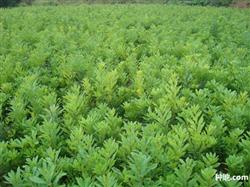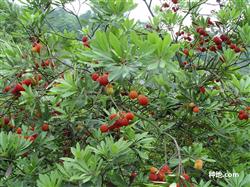How should bayberry seedlings be raised?

How should bayberry seedlings be raised? Please introduce that red bayberry seedlings can be raised by digging grafting or rootstock transplantation and then grafting, or after root cutting in the seedling field, and then grafting. In the area of Cixi and Yuyao, the technique of digging and grafting is basically adopted, which not only prolongs the grafting period, but also can be operated indoors, which greatly reduces the labor intensity and is not restricted by time, place and weather conditions. it also overcomes the disadvantage of excessive sap flow of 1 ~ 2-year-old red bayberry rootstock, which affects the survival rate of grafting. Using this method of grafting, the general survival rate is about 80%, and the number of seedlings per 666.7m2 can reach 7000 in the same year. 1. The grafting period and methods are from March 10 to April 10 every year. A week before grafting, dig red bayberry rootstocks in the rootstock field or buy bayberry rootstocks and store them indoors. The selected rootstocks should be 1 ~ 2 years old, and the thickness is about 0.6 ~ 1.0cm. The scion adopted is generally the fully mature, strong and full bud shoots in the outer middle and upper part of the crown of 7-15-year-old bayberry, and the spring shoot with leaves in the same year is better, and the thickness requires 0.5~1.0cm, and the base is consistent with the thickness of the rootstock. After picking the scion, the leaf should be cut off immediately (leave petiole). During grafting, the scion was cut into branches about the length of 8cm, and then cut down from the lower part of the spike into a "long cutting surface" that hurt the wood, which was about 3cm, and then turned the panicle into a "short cutting plane" at an oblique angle of 45 °, about 1cm. Before cutting the rootstock, the upper trunk of the rootstock should be cut off, leaving the base of the long trunk of 3cm. At one side of the cross section, one knife is cut longitudinally from top to bottom with a sharp knife, and its length is equal to or slightly longer than the "long cutting surface" of the scion. Then insert the cut scion into the incision of the rootstock, and the "long cutting surface" of the scion is close to one side of the incision of the rootstock, so that the two cambium are closely connected, then bind the whole grafting part with a thin film, and wrap the section of the upper end of the scion from top to bottom to reduce water evaporation. Scions and rootstocks should be grafted as soon as they are cut, and move quickly. When grafting, it is best that one person specializes in cutting ears and rootstocks, and the other person wraps the film to improve work efficiency. (2) it can be planted immediately after grafting, and can be preserved by pseudo-planting if the weather is not suitable. Bury the grafted seedlings in the indoor wet sand bed, bury the grafted parts, it is best to arrange them neatly, and the humidity of the sand should be pinched into clumps, it is appropriate to touch them, and it is not good to be too dry and wet; or first arrange the grafted seedlings neatly, spray the roots, and cover the grafted parts with thin film for preservation, which can not be preserved for too long. (3) the nursery should choose sandy mountain soil with loose and breathable soil, rich organic matter, acid or slight acid, and it is best to drain and irrigate. The nursery was arranged according to the requirements of 1 m wide border (including furrow), 0.4 m deep and 0.3 m wide. Planting time is the same as grafting time, it is best to choose non-rainy days to plant. There are two rows in each row, row spacing 20cm, plant spacing 6~7cm, generally 666.7m2 can plant 10 000 plants. The grafted seedlings of Myrica rubra must be cultivated in the nursery, which is at least not lower than the top 1cm of the scion. Under the protection of soil culture, the ratio of temperature to humidity is stable, which is beneficial to the healing, survival and growth of the interface. The scion sprouted in early May, and the soil covered on the bud can generally collapse automatically. If there is still a lump of soil pressed, it should be removed in time to facilitate germination. 4 Management of seedling stage in mid-May, check the survival rate of grafted seedlings and pull out dead seedlings in time; after grafted seedlings survive and germinate, the rootstock sprouts all and generally sprout less; in the nursery, the grafted seedlings should be fertilized frequently and fertilized once a month in June, July and August, mainly compound fertilizer, diluted to 0.5%. Remove weeds in the nursery in time, often carry out shallow and medium ploughing, loosen topsoil, and guard against damage to seedlings; timely drainage in the rainy season, and timely irrigation to fight drought during drought from July to August; diseases and insect pests are mainly used to control bayberry leaf rollers (commonly known as leaf rollers), twice a year, and larvae occur from the end of May to mid-June and from July to August. 50% fenitrothion EC and dichlorvos EC can be used for control. (5) the time for seedlings to come out of the nursery is generally between 2 and 3 months. The seedlings were graded according to dry height and stem diameter: dry height ≥ 40cm, stem diameter ≥ 0.5cm was grade 1, stem height ≥ 25cm, stem diameter ≥ 0.4cm was grade 2, and commercial seedlings were not used below grade 2. When raising seedlings, hurt the roots as little as possible, keep the roots intact, pick most of the branches and leaves in time, and reduce water evaporation. If the long-distance transportation, all the leaves of the branches are removed, and then the roots are dipped in mud and bandaged with straw to improve the survival rate of planting. Click to get more bayberry planting techniques click to get more fruit planting techniques
- Prev

What should we pay attention to when growing bayberry?
What should we pay attention to when growing bayberry? Please introduce Yangmei to choose uncultivated red and yellow soil hilly and mountainous area for intensive development. Waxberry is not only an economic forest, but also an ecological forest, which is beneficial to the improvement of ecological environment and has remarkable economic benefits.
- Next

How to make young bayberry trees bear fruit early?
How to make young bayberry trees bear fruit early? Please guide and introduce that if you want to make young bayberry trees bear early fruit, you can refer to the following planting techniques: first, planting in sandy mountain areas where ferns, rhododendrons and other broad-leaved trees are dominant, it is easy to plant early fruit and high yield. Open a contour terrace, dig a fixed planting hole of 1.2 × 0.8 meters, and apply 50 kg rotten fence fertilizer in the hole.
Related
- Moge, come on! The staff of the peasant association in the producing area of cantaloupe were frightened when the crowd gathered.
- Causes and Solutions of low Fruit setting rate of Apple
- Symptoms and control measures of passion fruit virus disease
- Fruit growing lesson: how do apple orchards keep high yields?
- Can you build orchards in the mountains? What are the pros and cons?
- How to manage the coloring period of Crisson grape?
- This paper introduces the processing technology of two kinds of fig products.
- How much is a month for retired teachers in rural areas by 2020?
- How can strawberry planting increase sugar content? We should pay attention to management in many aspects.
- What are the cultivation techniques on how to improve the yield of golden fruit?

